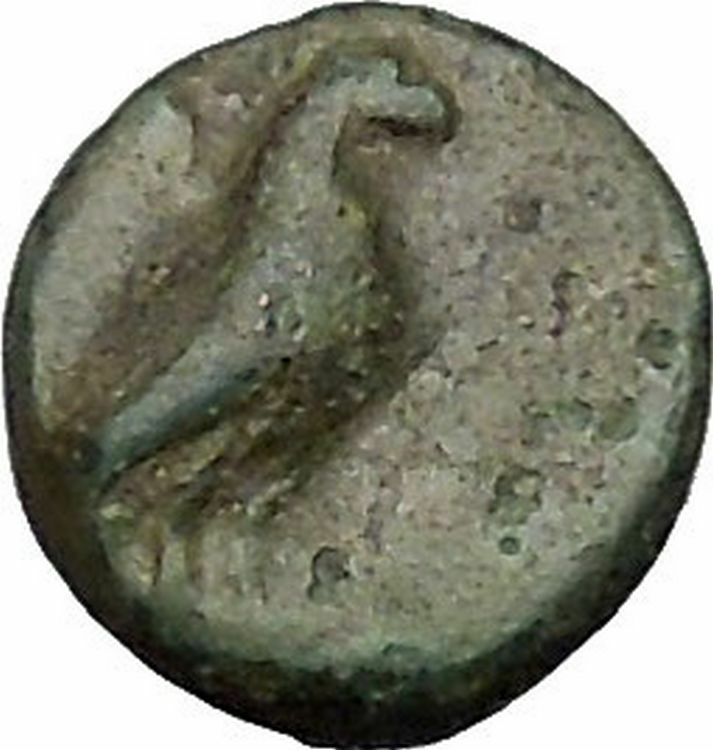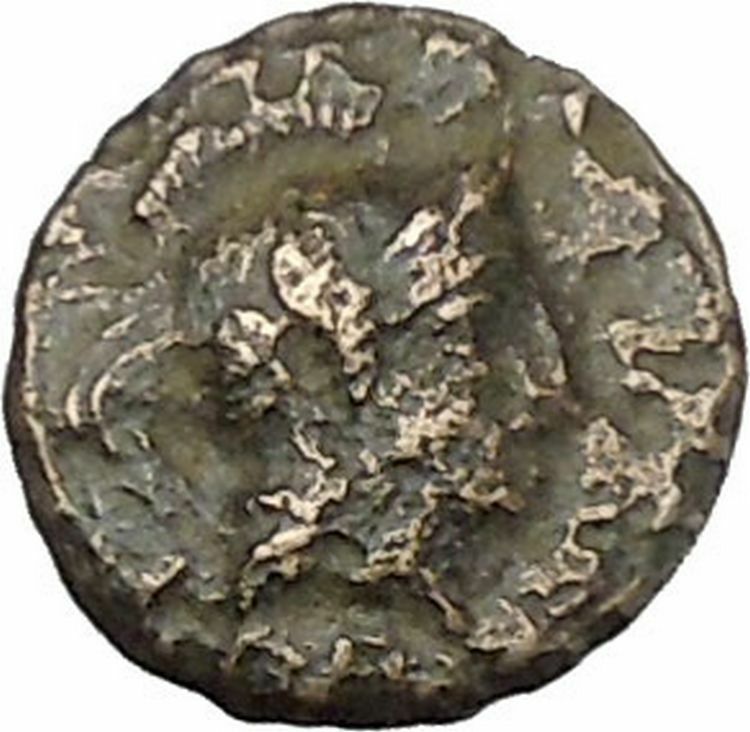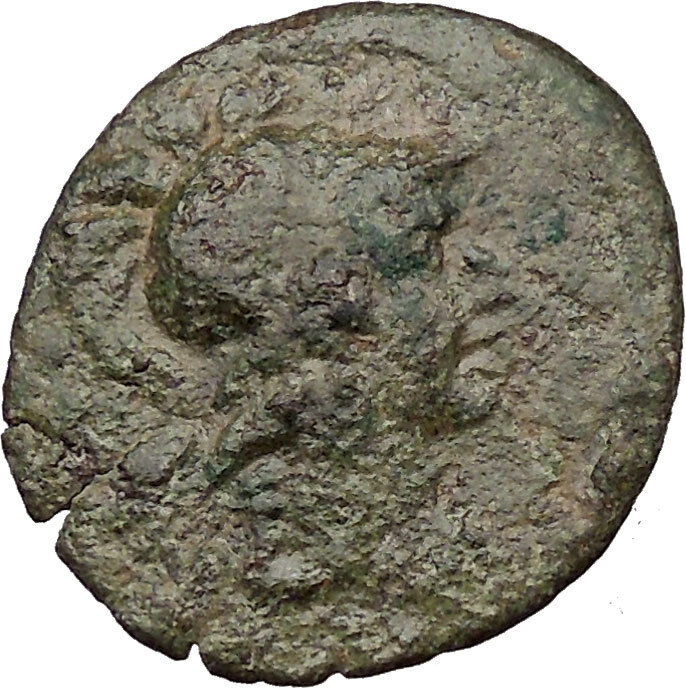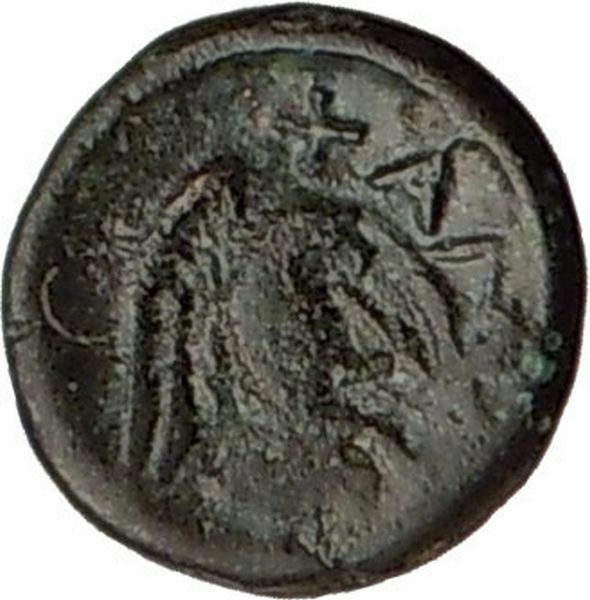|
Greek city of
Katane
in
Sicily
Bronze 17mm (2.92 grams) Struck late third century B.C.
Reference: HGC 2, 609; CNS III, p. 108-109, nos. 22-22 Ds 101/1
Jugate busts of Serapis, laureate and wearing atef crown, and Isis, wearing Isis
headdress.
KATANAIΩΝ, Apollo standing facing,
leaning on column, holding laurel branch and bow. Quiver and omphalos at feet.
Following the capture by Hieron of Syracuse, in 476 B.C., the
name of this city was changed to Aitna; but on the expulsion of the the new
colonists, fifteen years later, the place reverted to its original name of
Katane. It was captured in 404 B.C. by Dionysios of Syracuse who sold the
population into slavery. Katane submitted to Rome during the First Punic War.
You are bidding on the exact
item pictured, provided with a Certificate of Authenticity and Lifetime
Guarantee of Authenticity.
Serapis is a Graeco-Egyptian god. Serapis was devised during the
3rd century BC on the orders of
Ptolemy I of Egypt
as a means to unify the
Greeks and Egyptians in his realm. The god was depicted as Greek in appearance,
but with Egyptian trappings, and combined iconography from a great many cults,
signifying both abundance and resurrection. A
serapeum
(Greek serapeion) was any
temple or religious precinct devoted to Serapis. The
cultus
of Serapis was spread as a matter of
deliberate policy by the
Ptolemaic kings
, who also built an immense
Serapeum in Alexandria.

Serapis continued to increase in popularity during the
Roman period
, often replacing
Osiris
as the consort of
Isis in temples outside Egypt. In 389, a mob led by the
Patriarch
Theophilus of Alexandria
destroyed the
Alexandrian Serapeum, but the cult survived until all forms of religion other
than
Nicene Christianity
were suppressed or
abolished under
Theodosius I
in 391.
About the god
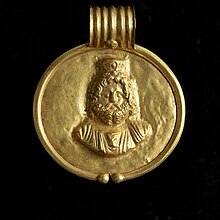
This pendant bearing Serapis’s likeness would have been worn by a
member of elite Egyptian society.
Walters Art Museum
,
Baltimore
.
“Serapis” is the only form used in Latin, but both
Ancient Greek
:
Σάραπις Sárapis and
Ancient Greek
:
Σέραπις Sérapis appear in Greek, as well as
Ancient Greek
:
Σαραπo Serapo in Bactrian.
His most renowned temple was the
Serapeum of Alexandria
. Under
Ptolemy Soter
, efforts were made to integrate
Egyptian religion with that of their Hellenic rulers. Ptolemy’s policy was to
find a deity that should win the reverence alike of both groups, despite the
curses of the Egyptian priests against the gods of the previous foreign rulers
(e.g.
Set
, who was lauded by the
Hyksos
).
Alexander the Great
had attempted to use
Amun for this purpose, but he was more prominent in
Upper Egypt
, and not as popular with those in
Lower Egypt
, where the Greeks had stronger
influence. The Greeks had little respect for animal-headed figures, and so a
Greek-style
anthropomorphic
statue was chosen as the
idol
, and proclaimed as the equivalent of the
highly popular
Apis
. It was named Aser-hapi (i.e.
Osiris-Apis), which became Serapis, and was said to be
Osiris
in full, rather than just his
Ka
(life force).
History
The earliest mention of a Serapis is in the disputed death scene of Alexander
(323 BC). Here, Serapis has a temple at
Babylon
, and is of such importance that he
alone is named as being consulted on behalf of the dying king. His presence in
Babylon would radically alter perceptions of the mythologies of this era: the
unconnected Babylonian god Ea (Enki)
was titled Serapsi, meaning ‘king of the deep’, and it is possible this
Serapis is the one referred to in the diaries. The significance of this Serapsi
in the Hellenic psyche, due to its involvement in Alexander’s death, may have
also contributed to the choice of Osiris-Apis as the chief Ptolemaic god.
According to Plutarch
, Ptolemy stole the
cult statue
from
Sinope
, having been instructed in a dream by
the “unknown
god” to bring the statue to
Alexandria
, where the statue was pronounced to
be Serapis by two religious experts. One of the experts was of the
Eumolpidae
, the ancient family from whose
members the hierophant
of the
Eleusinian Mysteries
had been chosen since
before history, and the other was the scholarly Egyptian priest
Manetho
, which gave weight to the judgement
both for the Egyptians
and the Greeks.
Plutarch may not be correct, however, as some Egyptologists allege that the
Sinope in the tale is really the hill of Sinopeion, a name given to the site of
the already existing
Serapeum
at
Memphis
. Also, according to
Tacitus
, Serapis (i.e., Apis explicitly
identified as Osiris in full) had been the god of the village of
Rhakotis
before it expanded into the great
capital of Alexandria.

High Clerk in the Cult of Serapis,
Altes Museum
,
Berlin
The statue suitably depicted a figure resembling
Hades
or
Pluto
, both being kings of the Greek
underworld
, and was shown enthroned with the
modius
, a basket/grain-measure, on his head,
since it was a Greek
symbol
for the land of the dead. He also held a
sceptre
in his hand indicating his rulership,
with Cerberus
, gatekeeper of the underworld, resting
at his feet, and it also had what appeared to be a
serpent
at its base, fitting the Egyptian
symbol of rulership, the
uraeus
.
With his (i.e. Osiris’s) wife
Isis, and their son
Horus
(in the form of
Harpocrates
), Serapis won an important place in
the
Greek world
. In his Description of Greece,
Pausanias notes two Serapeia on the slopes of
Acrocorinth
, above the rebuilt Roman city of
Corinth
and one at Copae in Boeotia.
Serapis was among the
international deities
whose cult was received
and disseminated throughout the Roman Empire, with
Anubis
sometimes identified with Cerberus. At
Rome, Serapis was worshiped in the Iseum Campense, the sanctuary of Isis built
during the
Second Triumvirate
in the
Campus Martius
. The Roman cults of Isis and
Serapis gained in popularity late in the 1st century when
Vespasian
experienced events he attributed to
their miraculous agency while he was in Alexandria, where he stayed before
returning to Rome as emperor in 70. From the
Flavian Dynasty
on, Serapis was one of the
deities who might appear on imperial coinage with the reigning emperor.
The main cult at Alexandria survived until the late 4th century, when a
Christian mob destroyed the Serapeum of Alexandria
in 385, and the cult was part of the general proscription of religions other
than approved forms of Christianity under the
Theodosian decree
.
Gallery
-
Oil lamp with a bust of Serapis, flanked by a crescent moon and star
(Roman-era
Ephesus
, 100-150)
-
Statuette possibly of Serapis (but note the
herculean
club) from
Begram
,
Afghanistan
-
Head of Serapis, from a 12-foot statue found off the coast of
Alexandria
-
Head of Serapis (Roman-era Hellenistic terracotta, Staatliches
Museum Ägyptischer Kunst, Munich)
Isis
or in original more likely Aset was a goddess in
Ancient Egyptian
religious beliefs, whose
worship spread throughout the
Greco-Roman world
. She was worshiped as the
ideal mother and wife as well as the matron of nature and magic. She was the
friend of slaves, sinners, artisans, the downtrodden, as well as listening to
the prayers of the wealthy, maidens, aristocrats and rulers. Isis is the Goddess
of
motherhood
,
magic
and
fertility
.
The goddess Isis (the mother of
Horus
) was the first daughter of
Geb,
god of the Earth, and
Nut
, the goddess of the Overarching Sky, and
was born on the fourth
intercalary day
. At some time Isis and
Hathor
had the same headdress. In later myths
about Isis, she had a brother,
Osiris
, who became her husband, and she then
was said to have conceived
Horus
. Isis was instrumental in the
resurrection of Osiris when he was murdered by
Set
. Her magical skills restored his body to
life after she gathered the body parts that had been strewn about the earth by
Set. This myth became very important in later Egyptian religious beliefs.
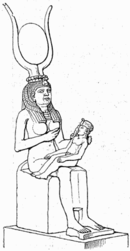
Isis nursing Horus, wearing the headdress of Hathor
Isis is also known as the goddess of
simplicity
, protector of the dead and goddess
of children from whom all beginnings arose. In later myths, the Ancient
Egyptians
believed that the
Nile River
flooded every year because of her
tears of sorrow for her dead husband, Osiris. This occurrence of his death and
rebirth was relived each year through rituals. The worship of Isis eventually
spread throughout the Greco-Roman world, continuing until the suppression of
paganism
Katane in Sicily
Foundationn
All ancient authors agree in representing Catania as a
Greek colony
named
Κατάνη (‘Katánē—see also
List of traditional Greek place names
) of
Chalcidic
origin, but founded immediately from
the neighboring city of
Naxos
, under the guidance of a leader named
Euarchos (Euarchus).
The exact date of its foundation is not recorded, but it appears from
Thucydides
to have followed shortly after that
of Leontini (modern
Lentini
), which he places in the fifth year
after
Syracuse
, or
730 BC
.
Greek
Sicily
The only event of its early history that has been transmitted to us is the
legislation of
Charondas
, and even of this the date is wholly
uncertain.
But from the fact that his legislation was extended to the other Chalcidic
cities, not only of Sicily, but of
Magna Graecia
also, as well as to his own
country, it is evident that Catania continued in intimate relations with these
kindred cities.
It seems to have retained its independence till the time of
Hieron of Syracuse
, but that despot, in
476 BC
, expelled all the original inhabitants,
whom he established at Leontini, while he repeopled the city with a new body of
colonists, amounting, it is said, to not less than 10,000 in number, and
consisting partly of
Syracusans
, partly of
Peloponnesians
.
He at the same time changed the city’s name to
Αἴτνη (Aítnē, Aetna or Ætna,
after the nearby
Mount Etna
, an active
volcano
), and caused himself to be proclaimed
the
Oekist
or founder of the new city. As such he
was celebrated by Pindar
, and after his death obtained heroic
honors from the citizens of his new colony.
But this state of things was of brief duration, and a few years after the
death of Hieron and the expulsion of
Thrasybulus
, the Syracusans combined with
Ducetius
, king of the
Siculi
, to expel the newly settled inhabitants
of Catania, who were compelled to retire to the fortress of
Inessa
(to which they gave the name of Aetna),
while the old Chalcidic citizens were reinstated in the possession of Catania,
461 BC
.
The period that followed the settlement of affairs at this epoch appears to
have been one of great prosperity for Catania, as well as for the Sicilian
cities in general: however, no details of its history are known till the great
Athenian
expedition to Sicily
(part of the larger
Peloponnesian War
).
On that occasion the Catanaeans, notwithstanding their Chalcidic connections,
at first refused to receive the Athenians into their city: but the latter having
effected an entrance, they found themselves compelled to espouse the alliance of
the invaders, and Catania became in consequence the headquarters of the Athenian
armament throughout the first year of the expedition, and the base of their
subsequent operations against Syracuse.
There is no information as to the fate of Catania after the close of this
expedition: it is next mentioned in
403 BC
, when it fell into the power of
Dionysius I of Syracuse
, who sold the
inhabitants as slaves, and gave up the city to plunder; after which he
established there a body of
Campanian
mercenaries.
These, however, quit it again in
396 BC
, and retired to
Aetna
, on the approach of the great
Carthaginian
armament under
Himilco
and
Mago
. The great sea-fight in which the latter
defeated
Leptines
, the brother of Dionysius, was fought
immediately off Catania, and the city apparently[ wordsweasel]
fell, in consequence, into the hands of the Carthaginians.
Callippus
, the assassin of Dion of Syracuse,
when he was expelled from Syracuse, for a time held possession of Catania (Plut.
Dion. 58); and when
Timoleon
landed in Sicily Catania was subject
to a despot named
Mamercus
, who at first joined the
Corinthian
leader but afterwards abandoned his
alliance for that of the Carthaginians, and was in consequence attacked and
expelled by Timoleon.
Catania was now restored to liberty, and appears to have continued to retain
its independence; during the wars of
Agathocles
with the Carthaginians, it sided at
one time with the former, at others with the latter; and when
Pyrrhus
landed in Sicily, Catania was the first
to open its gates to him, and received him with the greatest magnificence.
Catania was the birth-place of the philosopher and legislator Charondas; it
was also the place of residence of the poet
Stesichorus
, who died there, and was buried in
a magnificent sepulchre outside one of the gates, which derived from thence the
name of Porta Stesichoreia. (Suda,
under Στησίχορος.)
Xenophanes
, the philosopher of
Elea
, also spent the latter years of his life
there, so that it was evidently, at an early period, a place of cultivation and
refinement.
The first introduction of dancing to accompany the flute, was also ascribed
to
Andron
, a citizen of Catania
In ancient times Catania was associated with the legend of
Amphinomus and Anapias
, who, on occasion of a
great eruption of Etna, abandoned all their property, and carried off their aged
parents on their shoulders, the stream of lava itself was said to have parted,
and flowed aside so as not to harm them. Statues were erected to their honor,
and the place of their burial was known as the Campus Piorum; the
Catanaeans even introduced the figures of the youths on their coins, and the
legend became a favorite subject of allusion and declamation among the
Latin poets
, of whom the younger
Lucilius
and
Claudian
have dwelt upon it at considerable
length.
The occurrence is referred by
Hyginus
to the first eruption of Etna that took
place after the settlement of Catania.
Roman
rule
In the
First Punic War
, Catania was one of the first
among the cities of Sicily, which made their submission to the
Roman Republic
, after the first successes of
their arms in 263 BC. The expression of
Pliny
(vii. 60) who represents it as having
been taken by
Valerius Messalla
, is certainly a mistake.
It appears to have continued afterwards steadily to maintain its friendly
relations with Rome, and though it did not enjoy the advantages of a confederate
city (foederata civitas), like its neighbors Tauromenium (modern
Taormina
) and Messana (modern
Messina
), it rose to a position of great
prosperity under the Roman rule.
Cicero
repeatedly mentions it as, in his time,
a wealthy and flourishing city; it retained its ancient municipal institutions,
its
chief magistrate
bearing the title of
Proagorus; and appears to have been one of the principal ports of Sicily for
the export of corn.
It subsequently suffered severely from the ravages of
Sextus Pompeius
, and was in consequence one of
the cities to which a
colony
was sent by
Augustus
; a measure that appears to have in a
great degree restored its prosperity, so that in
Strabo
‘s time it was one of the few cities in
the island that was in a flourishing condition.
It retained its colonial rank, as well as its prosperity, throughout the
period of the
Roman Empire
; so that in the 4th century
Ausonius
in his
Ordo Nobilium Urbium
, notices Catania and
Syracuse alone among the cities of Sicily.
One of the most serious
eruptions
of
Mount Etna
happened in
121 BC
, when great part of Catania was
overwhelmed by streams of lava, and the hot ashes fell in such quantities in the
city itself, as to break in the roofs of the houses.
Catania was in consequence exempted, for 10 years, from its usual
contributions to the Roman state The greater part of the broad tract of plain to
the southwest of Catania (now called the Piana di Catania, a district of
great fertility), appears to have belonged, in
ancient times
, to Leontini or Centuripa (modern
Centuripe
), but that portion of it between
Catana itself and the mouth of the Symaethus, was annexed to the territory of
the latter city, and must have furnished abundant supplies of grain.
The port of Catania also, which was in great part filled up by the eruption
of
1669 AD
, appears to have been in ancient times
much frequented, and was the chief place of export for the corn of the rich
neighboring plains. The little river Amenanus, or Amenas, which flowed through
the city, was a very small stream, and could never have been navigable.
|













